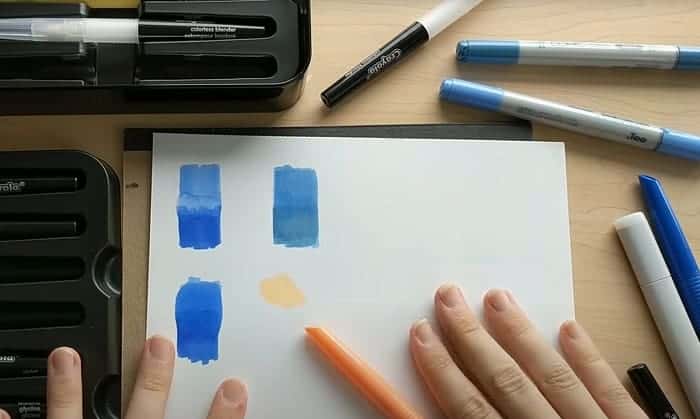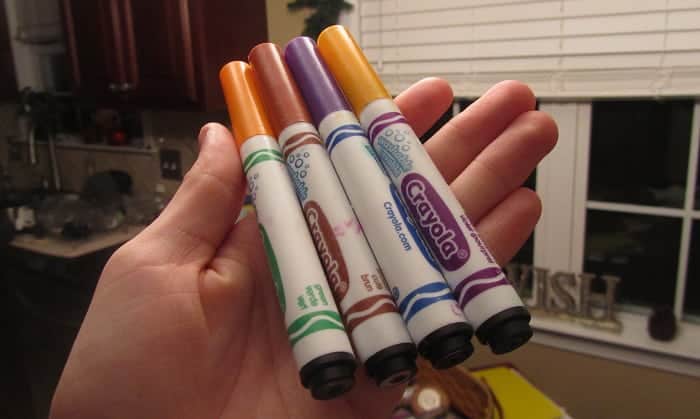Have you ever seen these calligraphies on Instagram with satisfying gradient colors and wondered how on earth they did that? Are you looking forward to coloring with Crayola markers, but they don’t have the vital colors to do the trick?
It is not money-wise to drive to the store and buy another set of markers just because you don’t have that one defining shade, nor is it a good idea to leave your work incomplete. In that case, this article is coming to save your day!
In this article, we are providing full instructions for five techniques on how to blend Crayola markers:
- Layering the Colors: Create new colors by overlapping a darker color on top of a lighter one until you achieve the desired color.
- Picking Up the Colors: Put the darker color onto a surface and use the lighter colored marker to pick up the darker color.
- One Tip Over Another: Gently rub the tip of one marker onto another.
- The Magical Solvent: Use water to blur the lines between different colors and merge them.
- Colorless Blender – Your Savior of the Day: Smoothen the color edges effortlessly by applying the colorless blender onto your drawings.
Table of Contents
What You Will Need
Crayola is most widely known for its crayon products. However, in recent years, the company has been making great efforts to produce a wide variety of products that are more appealing to their customers.
There are various types of markers, such as permanent, washable, classical, etc. I believe these markers are perfect for the blending techniques in this article.
Crayola have recently released a brand called the Crayola Blending Markers with 16 colors, but if you cannot afford these, you can still find a workaround for using the brand’s classic markers.
I will mention other materials needed for each method in their sections below. Once you have everything ready, let’s go to the next steps!
5 Simple to Blend Crayola Markers:
1. Layering the Colors
This first technique is the easiest among the five methods, and Crayola markers are all you will need. It is also one of the art techniques suggested by the company on its website.
For this method, you can use any shades of color from the Crayola series.
- Categorize your color shades from the lightest to the darkest.
- Start with the lighter-toned colors.
- Use a darker shade of the preceding colorant and overlap the tint onto the old one to create new colors.
- Keep coloring with your Crayola markers to gradually create a transition between the colors.
Avoid pressing your markers too hard and always make sure that you are handling them gently. If not, you will create visible harsh lines on your paintings, and they will look unattractive.
2. Picking Up the Colors
This technique may sound like a scam, but I am sure that it will do wonders. However, you will need to prepare a ceramic bowl, a piece of plastic, or anything else that is flat, smooth, and plastic-like so your marker ink can be picked up.
- Take the darker color and draw it into the middle of the bowl. Check that there is a good amount of ink.
- Take the lighter color marker and swipe its tips through the marker ink you’ve drawn in the bowl to pick up the darker color.
(It can be a bit tricky here. But try to angle the marker’s tip so that only a part of the tip, not the whole side, has a darker color on it. Otherwise, you will not see the desired blending in the end.)
- Holding the side that you’ve just colored in, and begin to draw.
- Once the ink runs out, repeat the process.
3. One Tip Over Another
This trick goes along with its name; it blends Crayola markers by letting the two tips touch each other. Like the above methods, it doesn’t require any additional material. However, you should carefully consider the combination of colors so that they complement each other. For example, green and yellow, red and orange, etc.
- Once you have chosen the perfect pair of markers, gently rub the tip of the darker colorant on that of the lighter hue. Be gentle so you won’t damage the markers’ tips.
- Use the lighter marker to start drawing. The darker shade might be dominant at first, but it will fade after a few strokes.
- As the marker returns to its original color, repeat the process until you are finished.
This trick and the previous methods are ideal for calligraphy as they help keep your writing neat and clean while also giving your work a pleasing gradient effect.
4. The Magic Solvent
As briefly mentioned in the introduction, we will need to prepare some clean water for this technique. In addition, we will need a paintbrush, or a cotton swab, and paper tape.
Your preferred color should be dark enough so that it won’t disappear when you apply the solvent.
- Start coloring with Crayola markers and keep the colors you would like to blend close to each other for better effect.
- Let it dry completely before you proceed to apply the solvent.
- While waiting, take out the paper tape and stick it around your drawing, according to the shape of where you want the blending effect. So, the applied water won’t smudge it later on.
(For instance, if you want the color to blend inside a circle, tape outside the circle.)
- Once the ink has dried up totally, wet your brush lightly by dipping the tip into the solvent.
- Slightly brush it over the surface where you want the color to merge.
- If the color is too vague because of the solvent, don’t panic. Sit tight until the paper is completely dry to add another layer of colors to it. Trying to write on wet paper will destroy it, and it will be unfixable.
This technique will be so helpful for painting and drawing since it is time-saving. It is especially great for blending large surface areas.
5. Colorless Blender – Your Savior of the Day
Last but not least, this is one of the simplest tips to blend Crayola markers. However, it requires you to have or buy a colorless blender, such as the Prismacolor Colorless Blender Marker, to be capable of proceeding with the following steps. Yet, if you already have your Crayola Blending Marker Kit, there are two colorless blending markers that you can use from there.
- Layer your colors as you would usually do. Make sure you apply enough colors to avoid an unevenly covered painting in the end.
- Take your colorless blender and slightly brush it over the edges or lines that differentiate the two colors to smoothen them. Voilà, your painting is finished flawlessly!
Conclusion
Knowing how to blend colors is a crucial skill that all artists need to acquire since it improves your work by creating a polished final look. Moreover, blending can be something fun to play with your children during quarantine.
I hope you have enjoyed this article and created astounding pieces of art. What techniques did you choose? Did it work? Let me know what you think in the comment section. If you find it helpful, please share it with others as well.
Furthermore, there are other tips and tricks you should try:

I am a former art teacher, so it is evident to me the importance of art in educating the new generation. We also want to help parents who plan to teach their children and desire the best tools and tips for them.


